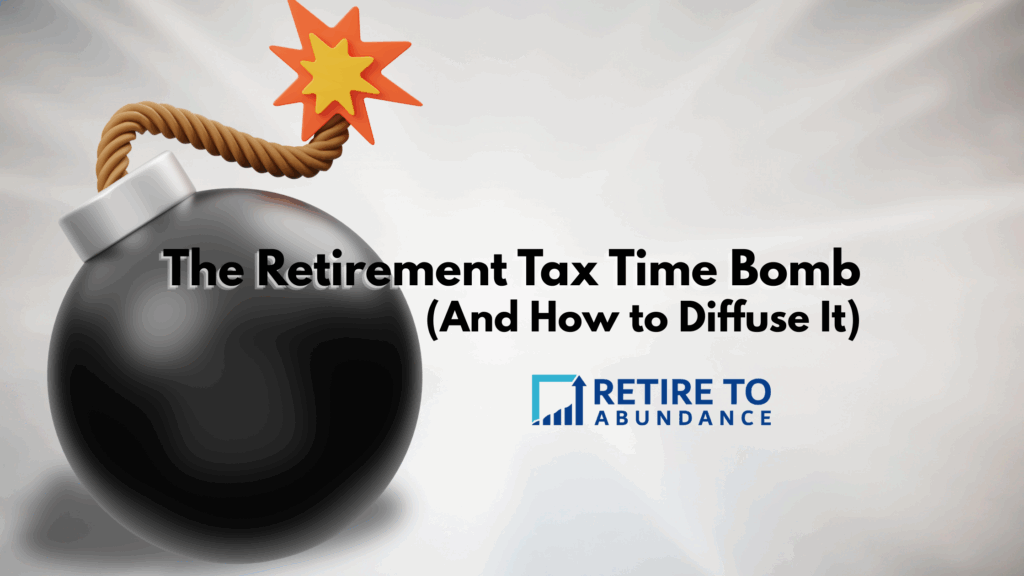If you’re like most people nearing retirement, you probably think the hard part is behind you. You worked hard, saved consistently, and now you’re looking forward to slowing down and enjoying what you’ve built.
Cue the hammock, the coffee mug that says “World’s Okayest Golfer,” and maybe a national park or two.
But hidden inside many well-funded retirement accounts is a tax time bomb that, if ignored, can quietly erode your nest egg faster than your grandkids can wipe out a tray of cookies.
Let’s unpack what this time bomb is, and more importantly, how to defuse it before it blows a hole in your travel plans.

The Problem: When Tax Deferral Backfires
For decades, the standard advice has been to shovel money into tax-deferred accounts like 401(k)s, 403(b)s, or Traditional IRAs. The idea is simple: defer taxes now while your income is high and pay taxes later when you’re in a lower bracket.
But here’s the plot twist: later rarely means lower.
Many retirees find themselves in higher tax brackets in retirement than they expected, especially once Required Minimum Distributions (RMDs) start knocking at age 73. These mandatory withdrawals can spike your income whether you need the money or not—which can increase your Medicare premiums, bump you into higher brackets, and even make you pay taxes on your Social Security.
Fun times.
This is the tax time bomb: a large, ticking tax liability hiding inside your retirement accounts, just waiting for the IRS to light the fuse.
Begin With the End in Mind
One of the most powerful tax strategies we help clients implement is simple in concept but profound in impact: stop focusing only on this year’s taxes. Start thinking about lifetime taxes.
Too often, folks get tunnel vision. “Should I deduct this now?” “Should I skip the Roth conversion because I don’t want to owe this year?”
Instead, ask: “How can I pay the least amount in taxes over the next 30 years?”
Our philosophy is simple: We believe in paying your fair share, but not leaving the IRS a tip.
A smarter, long-term strategy usually includes:
- Being intentional with pre-tax vs. Roth contributions while you’re working
- Taking advantage of low-income years early in retirement
- Strategically using Roth conversions to move money into tax-free territory while it’s on sale
Let’s dig deeper.
Be Thoughtful About Contributions
If you’re still working and deciding between Roth and Traditional contributions, don’t just look at your current tax rate. Peek into the future—your likely future tax rate matters just as much.
Some quick guidelines:
- If you’re early in your career or having a lower-income year, Roth contributions often make sense. You’re paying taxes while the IRS is giving out discounts.
- If you’re in peak earning years, Traditional contributions can help reduce your current tax bill—but beware of creating a monster-sized tax-deferred balance that will haunt you in retirement like a bad karaoke performance at your 20th class reunion
Can’t decide? That’s fine. Go 50/50. It’s the financial version of hedging your bets. Diversifying your tax buckets is every bit as important as diversifying your investments.
Because future tax law is about as predictable as Midwest weather.
Use the Roth Conversion Sweet Spot
Here’s where it gets fun! (Doesn’t everyone think taxes are fun? Just me, then.)
The early years of retirement can be a tax-planner’s playground. You’re not working anymore, you haven’t turned on Social Security yet, and Uncle Sam hasn’t forced you into RMDs. Translation: you have a few years where your income might be at its lowest point since your broke college days (minus the ramen).
That’s your Roth conversion sweet spot.
You can shift money from Traditional IRAs into Roth IRAs at lower tax rates. Yes, you’ll pay taxes now, but it’s like paying with a coupon. That money grows tax-free forever, can be withdrawn tax-free, and never faces RMDs.
Let’s say you retire at 62 and plan to delay Social Security until 67. That five-year gap can be your secret weapon. Use those years to fill up the lower tax brackets (think 10%, 12%, 22%) with Roth conversions.
The benefits?
- Smaller future RMDs
- Less taxable Social Security
- Lower Medicare premiums
- And a retirement portfolio with a growing slice of tax-free goodness
It’s the kind of planning move that makes your future self give you a high-five.

Keep the Big Tax Picture in Focus
Now, it’s tempting to just avoid taxes altogether. But unless you’re moving to a deserted island and bartering with coconuts, you’re going to pay some taxes. The goal is to pay less over time, not necessarily nothing this year.
That means running the numbers. Looking at Social Security timing, your projected income and withdrawals, how the market might treat you, and maybe even how Congress might tweak the rules.
I help clients map this out so they’re not flying blind. Because guesswork is not a retirement plan.
A Final Thought
I like to joke that the IRS is your silent partner in retirement—they’re always there, but you’d prefer they not take the lead.
The good news? With a little bit of early planning, you can dramatically reduce how much of your hard-earned savings end up going to Washington. We’re not about dodging taxes. We’re about paying what you owe—and not a penny more.
So, whether you’re five years from retirement or five months in, now is the time to make smart moves that your future self will thank you for.
Taxes may be inevitable—but tipping the IRS is optional.
And this is one place I suggest you don’t tip well.
This post is for education and entertainment purposes only. Nothing should be construed as investment, tax, or legal advice.

